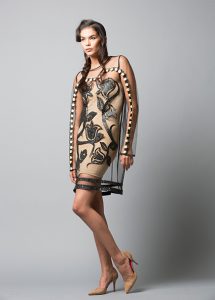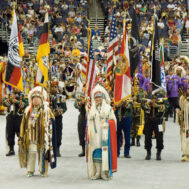The Native Fashion Now exhibit opened February 16 at the Smithsonian’s National Museum of the American Indian George Gustav Heye Center in New York. The show represents the innovations of over 50 years of contemporary indigenous fashion with the majority of the pieces being the creation of Native Americans. Sixty-seven US and Canadian artists and designers are represented in the exhibit that showcases the melding of generations-old design and technique and contemporary couture.

Orlando Dugi (Diné [Navajo]), cape, dress, and headdress from “Desert Heat” collection, 2012. Silk, organza, feathers, beads, and 24k gold; feathers, beads, and silver; porcupine quills and feathers. Model: Julia Foster. Hair and makeup: Dina DeVore. Photo by Nate Francis/Unék Photograph
From a totem pole designed dress to intricately beaded foot wear, native design-inspired urban street wear, to traditionally crafted jewelry incorporating non-traditional alloys, over 100 pieces express the height of contemporary indigenous fashion.
Traditional materials such as feathers, beads, buckskin and quills are unifying ingredients that link the fashion pieces to pueblo and tribal counterparts, but the outcome is something uniquely modern.
Take, for example, David Gaussoin and Wayne Nez Gaussoin’s (Diné [Navajo])/Picuris Pueblo) Postmodern Boa, made from stainless steel, sterling silver, enamel, paint, and feathers, that rests on the shoulders and rises in a serpentine, feathered swirl around the head and neck of its wearer.
Or consider Alano Edzerza’s (Tahltan) cotton Chilkat tunic in striking black and white, patterning utilizing Northwestern tribal symbols.
Diné designer Orlando Cape’s fiery feathered-capped dress from his “Desert Heat” Collection utilizes painted silk, organza, feathers, beads, and 24k gold; its feathers evoke the essence of a desert southwestern sky at sunset.
Jamie Okuma’s (Luiseño/Shoshone-Bannock) creation, hand-beaded Christian Louboutin Boots, utilizes glass beads from the 1880s, repurposed to cover the boot’s surface, forms a bold collage of western tribal motifs.
Although Native Fashion Now celebrates the creativity and innovation of these artists and designers, success is a hard-won endeavor that comes with a unique set of obstacles: One of the challenges that Native American artists face is the integration into their work of designs that carry sacred connotations. The majority of contemporary artists don’t live in their pueblo or tribe of origin and may not be aware of the ceremonial significance of an artistic element. It remains to be seen how tribal spiritual leaders and tribal law can or should impact the work of contemporary artists.

Bethany Yellowtail (Apsáalooke [Crow] and Northern Cheyenne) for B Yellowtail, Old Time Floral Elk Tooth dress, Apsáalooke Collection, 2014. Lace, leather appliqué, and elk teeth. Peabody Essex Museum, 2015.22.1. Photo by Thosh Collins.
At the show’s opening, in March 2016 at the Peabody Essex Museum in Salem, MA, the museum hosted a roundtable discussion with three artists, Jamie Okuma (Shoshone), Patricia Michaels (Taos Pueblo), and Pat Pruitt (Laguna Pueblo) that further captured some of the intricacies of incorporating ancient tradition with modern innovation.
Kathleen C. Stone, writing for Arts Fuse, captured the discussion: “The artists at the roundtable shared thoughts about the specter of assimilation. Most Native artists learn about technique and the spiritual significance of traditional design by working on ceremonial garments and objects for the tribe. When it comes to their own art, they draw on all that makes them who they are, including tribal traditions, and that motivates them when it comes to deciding what to use in their artistic and commercial enterprises. “Whatever we’re doing as artists is to be seen, and sold.” Okuma said. On the other hand, some of their creations must remain out-of-sight from the public. “Ceremonial life remains private to the pueblo,” insists Pruitt.”
“One audience member raised the tricky issue of cultural appropriation this way: “What advice can I give fashion students who are inspired by Native art?” When answering, Okuma pointed out the Isaac Mizrahi dress on display in the gallery: “It’s beautifully done, in a respectful manner. But before using a design, an artist should write to the tribe for guidance. Get permission. Your work must bear the integrity of who you are and where the elements came from.” Michaels offered this as summary: “We are artists, and we are still here, after all the genocides, dislocations, and pillaging. We are proud of who we are, and want to be part of the larger world, while also celebrating our own culture.”
The exhibit will remain at the Smithsonian’s National Museum of the American Indian through September 4, 2017.

Jamie Okuma (Luiseño and Shoshone-Bannock), boots, 2013–14. Glass beads on boots designed by Christian Louboutin. Museum commission with support from Katrina Carye, John Curuby, Karen Keane and Dan Elias, Cynthia Gardner, Merry Glosband, and Steve and Ellen Hoffman. Peabody Essex Museum, 2014.44.1AB. Copyright 2015 Peabody Essex Museum. Photo by Walter Silver.
 Margaret Roach Wheeler (Chickasaw) for Mahota Handwovens, The Messenger (The Owl) cape and headpiece, from the Mahotan Collection, 2014. Silk-wool yarn; silk-wool yarn, metal, silver, glass beads, and peacock feathers. Courtesy of the designer. Photo by Greg Hall.
Margaret Roach Wheeler (Chickasaw) for Mahota Handwovens, The Messenger (The Owl) cape and headpiece, from the Mahotan Collection, 2014. Silk-wool yarn; silk-wool yarn, metal, silver, glass beads, and peacock feathers. Courtesy of the designer. Photo by Greg Hall. 

